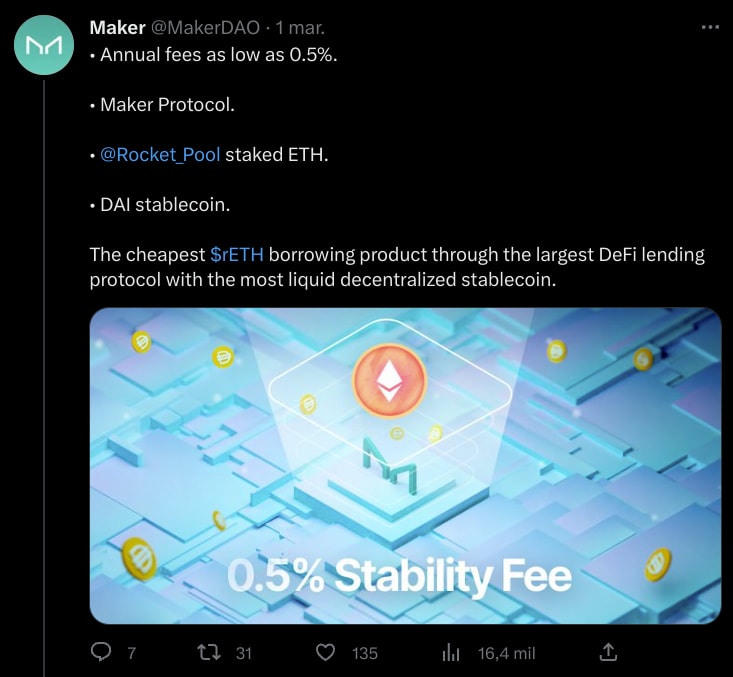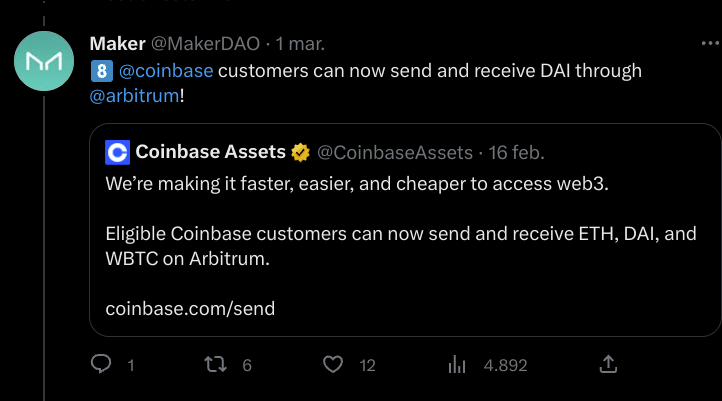Analysing MKR surge
We can see that the price before the low fees was approximately 870, while after the low fees it is increasing, reaching 960.
Firstly, after the introduction of low fees, transfers volume has seen a remarkable increase, rising from a volume of 18M to 70M. This indicates that the lower fees have made transfers more accessible and attractive to users, resulting in a significant increase in transfer activity. Additionally, the average transfer also shows an upward trend, indicating that users are transferring larger amounts of money.
Secondly, the number of users transferring has experienced a significant surge after the announcement of low fees. The graph shows that before the fee reduction, there were 289 users transferring, while after the announcement, this number skyrocketed to 621 users transferring. However, it is worth noting that the number of users transferring has been decreasing during the following days, possibly indicating that the novelty of the fee reduction has worn off.
Finally, the transfers over time have also seen considerable growth. The graph shows that transfers went from 624 to 1.8k, indicating that users are transferring money more frequently. Although transfers have gone down in the following days, they have remained stable.
Firstly, before the low fees, the distribution of transactions by volume size per period was relatively even, with no clear band dominating. However, the $1k-$10k band was the most prominent. After the introduction of low fees, the $1k-$10k band became the most significant, indicating a considerable increase in the number of transactions in this range. This suggests that users are now more willing to transfer larger amounts of money due to the lower fees.
Secondly, the volume distribution by size and period shows a significant change after the introduction of low fees. Before the fee reduction, the leading range was $100-$1k, with a total of 85M transactions. However, after the introduction of low fees, this range plummeted to just 600k transactions. This indicates that the lower fees have incentivized users to transfer larger amounts of money, leading to a shift in the volume distribution.
Thirdly, the distribution of transactions by volume size over time shows that the $1k-$10k range has been gaining strength after the introduction of low fees. This suggests that users are becoming more comfortable with transferring larger amounts of money, possibly due to the lower fees.
Finally, the volume distribution graph shows a significant increase in the range >$100k, with this range now having the highest volume. This indicates that high-value transfers are becoming more prevalent, possibly due to the lower fees making these transactions more feasible for users.
Firstly, the distribution of swaps by pool shows a significant increase in the MKR-WETH BLP pool, from 63 swaps to 152 swaps. This indicates that users are now more willing to swap in this pool, possibly due to the lower fees.
Secondly, the MKR volume swapped has also increased significantly after the introduction of low fees. Before the fee reduction, there was a total of 74k in the MKR-WETH BLP pool. However, after the fee reduction, the volume swapped has increased to 259k. This suggests that the lower fees have incentivized users to swap more MKR tokens.
Thirdly, the distribution of swaps by pool shows that there were two more pools at the end of February, but they had a negligible percentage of activity. Now there is no activity in these pools, only in the MKR-WETH BLP pool. This suggests that users are now solely focusing on the most active pool.
Finally, the MKR volume swapped distribution by pool over time shows that all the volume is in the same pool: MKR-WETH BLP. This indicates that users are only swapping MKR tokens in this pool, possibly due to the lower fees making it a more attractive option.
- After the low fees, transfers volume has risen considerably. They have gone from a volume of 18M to 70M. The average transfer also has an upward trend.
- The number of users transfering by period has skyrocketed. Before the low fees there was a total of 289 users transfering while after the announcement of the low fees there was a total of 621 users transfering. However, this number has been decreasing during the following days.
- The transfers over time have risen considerably. They went from 624 to 1.8k. During the following days they have gone down but remained stable.
- In the distribution of transactions by volume size per period, before low fees there was no clear band that predominated, although the first was the $1k-$10k band. After the low fees the band with the highest distribution of transactions is $1k-$10k. It has increased considerably.
- The volume distribution by size and period, before the low fees, the leading range was $100-$1k, with 85M. After the low fees it has plummeted to 600k.
- In the distribution of transactions by volume size over time, the $1k-$10k range has been gaining strength after the low fees.
- In the volume distribution we can see that the range >$100k has increased a lot, being the range with the highest volume.
- In the distribution of swaps by pool we see that the MKR-WETH BLP pool has increased significantly, from 63 swaps to 152 swaps.
- The MKR volume swapped has also increased a lot. Before the low fees there was a total of 74k in the MKR-WETH BLP pool and then the volume swapped has increased to 259k.
- In the distribution of swaps by pool, at the end of February there were two more pools but with a negligible percentage. Now there is no activity in these pools, only in the MKR-WETH BLP pool.
- In the MKR volume swapped distribution by pool over time, all the volume is in the same pool: MKR-WETH BLP.
MakerDAO is a decentralized organization based on the Ethereum blockchain that provides a platform for creating a stablecoin, Dai, which is pegged to the value of the US dollar. The MakerDAO system uses a collateralized debt position (CDP) model to stabilize the value of Dai and maintain its 1:1 peg with the dollar. Users can deposit a variety of cryptocurrencies as collateral and borrow Dai, allowing them to maintain a bullish position on the value of their cryptocurrencies while using Dai as a stable store of value.
MakerDAO's system is based on a smart contract platform that enables a completely decentralized and autonomous system, eliminating the need for intermediaries and trusted third parties. The MakerDAO system is managed by a decentralized community of token holders and governed by the MakerDAO Foundation, a non-profit organization dedicated to advancing the development and adoption of the Dai stablecoin.
One of the key innovations of MakerDAO is the use of a unique governance token, MKR, which is used to manage the system and make decisions about its operation. Holders of MKR have the ability to participate in the decision-making process, including setting collateral requirements, adjusting interest rates, and managing the supply of Dai.
On March 1, 2023, MakerDAO announced a reduction in annual fees to less than 0.5%, making it even more attractive for users to utilize the platform. Additionally, Coinbase has recently enabled the use of Dai on Arbitrum, a popular layer 2 scaling solution for Ethereum, further expanding the utility and reach of the MakerDAO system.
Through its innovative solutions and technology, MakerDAO has revolutionized the world of decentralized finance and created a powerful platform that is changing the way we think about stablecoins and financial systems.
The analysis conducted above focused on the study of various charts related to swap and transfer activity on a cryptocurrency platform.
This analysis was conducted in the context of two important news items that emerged in the cryptocurrency world in the same time period. On 1 March, the reduction of annual fees to less than 0.5% was announced on the analysed platform, while Coinbase enabled the use of DAI on Arbitrum.
To conduct the analysis, we have focused in the following metrics:
- MKR price before and after the event
- Transfers volume and average transfer size by period
- Number of users transfering by period
- MKR transfers over time
- Distribution of transactions by volume size per period
- MKR volume distribution by size and period
- Distribution of transactions by volume size over time
- MKR volume distribution by size over time
- Distribution of swaps by pool and period
- MKR volume swapped distribution by pool
- Distribution of swaps by pool over time
- MKR volume swapped distribution by pool over time


